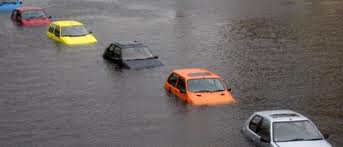Buyer Beware: Flood Damaged Cars
The historic flash floods in Colorado last week left a path of death and destruction in their watery wake. Among the debris, the floods left tens of thousands of water-damaged vehicles. You can be sure the insurance claims are piling up. You can be equally sure some of those flooded cars will find their way into the California used car market next year. How do you protect yourself against buying a water-wreck?

Certainly you can – and should – ask the dealer whether the car has been in a flood, just as you should always ask if a car has been in a previous wreck. But you can rarely be sure that the salesman will know the car’s prior history and be truthful about what he knows. So, what should you look for in buying a used car? What are the “symptoms” of prior flood damage?
All of your senses should be on high alert.
First, do not underestimate the power of smell. A flood-damaged car often has suffered from some kind of mold. The aroma of mildew or mold is a huge red flag. Be particularly wary if the saleman has opened all the windows. Close the windows and doors, and remove any air freshener the dealer has installed. Any dank odor should convince you to buy a different car without much further investigation.
Secondly, put your sense of touch into service. Feel all the carpeting; peel it back. Feel under the seats and under the floor mats. Then open the trunk and feel the liner as well. Run your hand along any place where water could possibly collect, even the spare tire or tool box. Any sense of moisture is suspect. A new car, even a new used car, should feel perfectly dry. Where metal should be smooth, a rough spot could be the early stages of rust.
Third, search for visual signs of corrosion, rust or stains of mildew or mold. Again, check inside the trunk, as well as the passenger compartment. Rust may be barely visible at the edges of screws, hinges, doors, headlights, grille, seat tracks, and anywhere paint has been dented or chipped. Take a small flashlight with you. Poke around under the dashboard to see if the electrical wires are damaged or brittle; water damage can be devastating to the electrical system of any vehicle. Make sure all the lights are functioning, including dashboard warning lights, and exterior lights and blinkers. And, check for signs of condensation inside the glass. Don’t hesitate to look under the car and under the hood.
Fourth, use your ears. A rusty door may creak on its hinges; a corroded trunk latch may close with a screech. Turn on the ignition yourself; do not leave this critical task to the salesman. Try the air conditioning and windshield wipers. Open the windows and the sunroof, if there is one. All mechanical functions should work without any audible complaint. You should even turn on the radio, as static is a common trait of a water-damaged system.
Most dealers are careful to detail the vehicles before putting them out on the car lot for sale. At first glance the car may look clean and shiny. But on closer inspection, a flood-damaged car may show signs of dirt, mud or the residue of debris.
Finally, ask to see the car title, before you buy the vehicle. It may have a salvage brand or flood-damaged title, if it has been the subject of an insurance claim. A CarFax report may be useful, but is not totally reliable, as many factors – even a prior wreck – are not reflected in this document until long after the fact.
Flood damaged cars, at best, are worth much less than a car which has not suffered such abuse. At worst, they may have dangerous electrical defects or frame damage, and should not be sold at all. When buying a used car, use the sensory tools of sight, smell, hearing, touch – and then add a large dose of good common sense.

